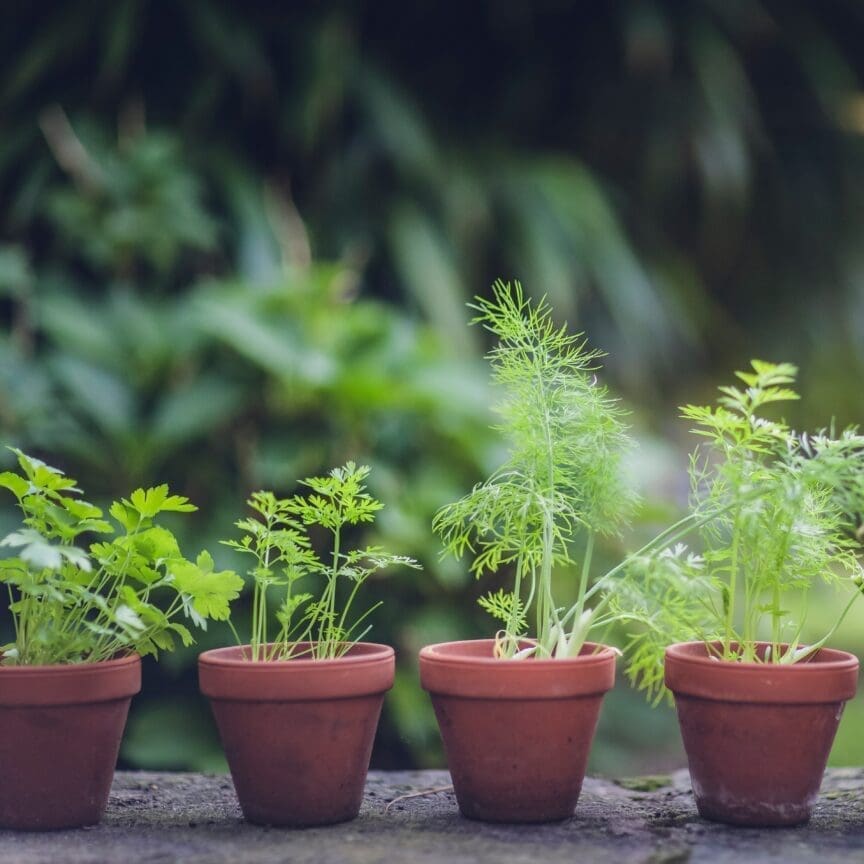Growing a small container or raised bed herb garden makes it easy to grab a handful of basil for a pasta, a sprig of rosemary to sprinkle over potatoes, or pick a few chillies to spice up a curry.
Creating a DIY herb garden can be easy and I’m going to give you some information that will hopefully convince you to spice up your home and grow an herb garden.
One of the main reasons I love growing herbs is that for a food crop you don’t need much to make a big impact. In other words, herbs (and spices) can be grown just about anywhere in even the smallest spaces and you only need to harvest a minimum amount to bring maximum flavour to your food.
When you buy fresh herbs from the supermarket, you generally only use a small portion of them. It would make more financial sense to grow your own fresh organic herbs, harvesting what you need and then regrow them back!
Some of the best herbs and spices to grow are: basil, rosemary , thyme , mint, coriander, garlic chives, oregano, ginger, turmeric, chillies, dill, parsley, fennel and sage
Most herbs and spices are extremely easy to grow – much easier than it is to grow regular fruit and vegetables and that’s why you often see them grown in quirky places such as wheelbarrows and on windowsills.
Herbs will grow best in good fertile soil in a free draining garden bed or use a premium potting mix in containers, small raised beds and large pots. With regular water and reasonable sunlight your herb garden should flourish. Having said that, most herbs will do just fine if somewhat neglected, which makes them an ideal food crop for a busy gardener.
All herbs can be used separately or combined to create the base for many of the world’s most famous dishes. Or, if you’re like me, you can experiment and make your own unique combinations, that will impress your family and guests.
Most herbs grow well in containers or together in a small garden to make a spectacular edible display. In a smaller garden setting (or even a larger one) dedicating a specific area for your herbs can make them easier to manage and harvest when required.
Perennial herbs or continuous herbs like Thai basil, galangal, cardamom leaf, bay leaf, rosemary and native Australian ginger will grow all year in most places so using them for food and as ornamentals can be the perfect addition for an urban setting.
Annual herbs such as basil, coriander and dill will readily self-seed and then grow back next season in the same area often germinating at the best growing time for the plant. I tend to let the seedlings grow where they come up or sometimes, I’ll dig them whilst small and replant to other areas of the garden.
Finally, remember this, it was the herb and spice trade from Java to China into the Middle East and Africa all the way to Europe that first opened the world thousands of years ago to discovery, sharing of knowledge and cooperation between nations. So, why not grow some of that ancient history in your very own space (no matter what size) and experience the organic flavour and fragrance of home-grown herbs.
Photo: Markus Spiske for Unsplash
MARK VALENCIA
Mark Valencia retired from the Australian Army after 21 years of service and is married with two children (boys). He has always been passionate about self-sufficiency and he is enjoying the opportunity to communicate this passion through his blog and YouTube channel about self-sustainment by growing fruit and vegetables and keeping animals. Visit selfsufficientme.com


